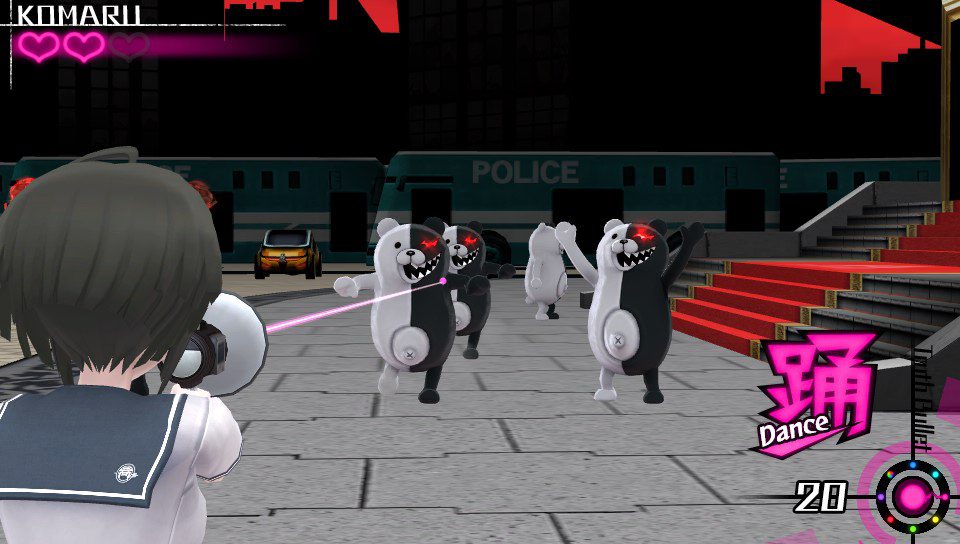Some series engender heated debates, with supporters enamored beyond comprehension, while detractors will take any chance to dismiss the series. Danganronpa is a series that precious few people I know are tepid on. Oddly enough, I was extremely dismissive of the series initially (full disclosure and all that), so the thought of diving into Danganronpa Another Episode: Ultra Despair Girls was nerve-wracking. Strangely, I have just woken from a Danganronpa coma in which I digested each game in the series simply based on my love for Ultra Despair Girls. It was a strange experience.
The Danganronpa games are visual novels first and games second. This isn’t terrible unusual for JRPG’s, but certain series hit that mark better than others. Ultra Despair Girls does nothing to challenge that approach, but it is far more survival action than mystery novel. Thankfully, the story is just as deep as previous games, it’s just approached in a very different way.
As the sun rises on Komaru Naegi, our less-than-eager hero, the world around Naegi starts to form, explaining her forced captivity over the past year where she is isolated from human contact. Her apartment is thankfully spacious and lovely, but she is a prisoner. The setup feels much like that of the classic Oldboy, without being quite as dark or explicit. When chaos descends, as it has to, Naegi’s introduction to the outside world becomes just as jarring to us as it does to her. The set up is a fairly familiar setup, but one pulled off with style.
Naegi is quickly joined on her quest by Toko Fukawa (remember her from the first game?), a mousy school-girl caught in a 50 Shades-esque relationship who happens to have a psychotic alter-ego. Toko’s combat side is an enormous help in the early stages of the game. While her “battery life” is finite, her skills are such that she can wipe out areas of Monokuma quickly, letting you reserve Naegi’s very limited ammo for more important spots. Toko ends up being not only the best combatant, but the most bizarrely delightful character as well. With only two main heroes, there is a chance at a more in-depth take on both, something I felt the other entries sorely missed.
What sets Ultra Despair Girls apart from the other entries is the actual action portion of the game. It is, for the most part, going to be seen as a third-person shooter. The bulk of the gameplay involves running around a poorly rendered world, made up of corridors so you won’t get lost, and shooting Monokuma’s of varying types with Truth Bullets, also of varying types. Bullets range from straight damage based, to bullets that inspire enemies to dance, as well as projectiles for operating puzzles. Naegi’s hacking gun is depressingly simple at first, but as your stock of ammo types rise, so do the puzzle aspects of Ultra Despair Girls, which is where the real meat is.
For the most part, the game looks and feels like a mid-generation Playstation 2 game. The graphics are extremely dated, and the movement, both traversing the map and aiming your gun, feels pretty terrible at first. If you can get over the step back in time, adjusting to the controls is fairly easy, if not a little frustrating. It is incredibly odd that the (arguably) terrible look and feel don’t ruin the game. In fact, as puzzles become more intricate and clever, the limited world and poor graphics start to make a kind of sense, and eventually become mouth-wateringly fun. Puzzles and relationships are the core of this series, so even though it takes a few hours to get into the really meaty content, it is there. As a fan of the third-person action take, I found the puzzle portions to be far better constructed and enjoyable this time around, although your mileage will vary depending on your love for the traditional mechanics.
Verbiage is certainly not an issue with Ultra Despair Girls, to the degree of almost being TOO dense. There are blocks between conversation and action that wreck any sense of momentum between either aspect. Shooting three Monokuma’s, then sitting through 15 minutes of dialogue, then shooting two more before returning to more dialogue. . . The process repeats. A lot. Since the shooting mechanics are so rudimentary, being pulled out and put back only works to ruin your comfort and realize just how bad the game controls. One can reach an equilibrium between the two (I did), but it is a strange and jarring situation for the first few hours.
Danganoronpa is a series that is really just a moving book. The games are able heavily inspired by games like Phoenix Wright, and that worked wonders with the disturbing and occasionally grotesque stories. This attempt to make them more “exciting” might be something done to appeal to a wider audience, but it makes it more esoteric. You really have to love the story to slog through some of the weaker parts of the game. There are plenty of glitches and bugs that prevent a smooth experience, and can end up with game overs for being a mere second off, or just a tad off course. For fans of the series, the changes will probably be a hit, deservedly so. Ultra Despair Girls is a fantastic entry for those of us invested in the series, but probably a terrible introduction for anyone coming into the world fresh.







